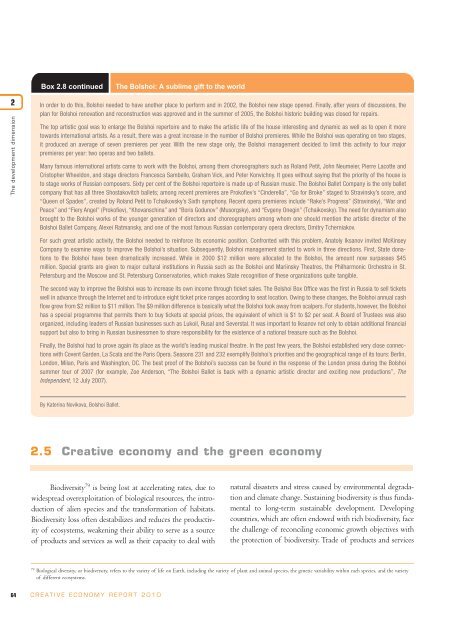Creative Economy: A Feasible Development Option
Creative Economy: A Feasible Development Option
Creative Economy: A Feasible Development Option
- No tags were found...
Create successful ePaper yourself
Turn your PDF publications into a flip-book with our unique Google optimized e-Paper software.
Box 2.8 continuedThe Bolshoi: A sublime gift to the world2The development dimensionIn order to do this, Bolshoi needed to have another place to perform and in 2002, the Bolshoi new stage opened. Finally, after years of discussions, theplan for Bolshoi renovation and reconstruction was approved and in the summer of 2005, the Bolshoi historic building was closed for repairs.The top artistic goal was to enlarge the Bolshoi repertoire and to make the artistic life of the house interesting and dynamic as well as to open it moretowards international artists. As a result, there was a great increase in the number of Bolshoi premieres. While the Bolshoi was operating on two stages,it produced an average of seven premieres per year. With the new stage only, the Bolshoi management decided to limit this activity to four majorpremieres per year: two operas and two ballets.Many famous international artists came to work with the Bolshoi, among them choreographers such as Roland Petit, John Neumeier, Pierre Lacotte andCristopher Wheeldon, and stage directors Francesca Sambello, Graham Vick, and Peter Konvichny. It goes without saying that the priority of the house isto stage works of Russian composers. Sixty per cent of the Bolshoi repertoire is made up of Russian music. The Bolshoi Ballet Company is the only balletcompany that has all three Shostakovitch ballets; among recent premieres are Prokofiev’s “Cinderella”, “Go for Broke” staged to Stravinsky’s score, and“Queen of Spades”, created by Roland Petit to Tchaikovsky’s Sixth symphony. Recent opera premieres include “Rake’s Progress” (Stravinsky), “War andPeace” and “Fiery Angel” (Prokofiev), “Khovanschina” and “Boris Godunov” (Musorgsky), and “Evgeny Onegin” (Tchaikovsky). The need for dynamism alsobrought to the Bolshoi works of the younger generation of directors and choreographers among whom one should mention the artistic director of theBolshoi Ballet Company, Alexei Ratmansky, and one of the most famous Russian contemporary opera directors, Dmitry Tcherniakov.For such great artistic activity, the Bolshoi needed to reinforce its economic position. Confronted with this problem, Anatoly Iksanov invited McKinseyCompany to examine ways to improve the Bolshoi’s situation. Subsequently, Bolshoi management started to work in three directions. First, State donationsto the Bolshoi have been dramatically increased. While in 2000 $12 million were allocated to the Bolshoi, the amount now surpasses $45million. Special grants are given to major cultural institutions in Russia such as the Bolshoi and Mariinsky Theatres, the Philharmonic Orchestra in St.Petersburg and the Moscow and St. Petersburg Conservatories, which makes State recognition of these organizations quite tangible.The second way to improve the Bolshoi was to increase its own income through ticket sales. The Bolshoi Box Office was the first in Russia to sell ticketswell in advance through the Internet and to introduce eight ticket price ranges according to seat location. Owing to these changes, the Bolshoi annual cashflow grew from $2 million to $11 million. The $9 million difference is basically what the Bolshoi took away from scalpers. For students, however, the Bolshoihas a special programme that permits them to buy tickets at special prices, the equivalent of which is $1 to $2 per seat. A Board of Trustees was alsoorganized, including leaders of Russian businesses such as Lukoil, Rusal and Severstal. It was important to Iksanov not only to obtain additional financialsupport but also to bring in Russian businessmen to share responsibility for the existence of a national treasure such as the Bolshoi.Finally, the Bolshoi had to prove again its place as the world’s leading musical theatre. In the past few years, the Bolshoi established very close connectionswith Covent Garden, La Scala and the Paris Opera. Seasons 231 and 232 exemplify Bolshoi’s priorities and the geographical range of its tours: Berlin,London, Milan, Paris and Washington, DC. The best proof of the Bolshoi’s success can be found in the response of the London press during the Bolshoisummer tour of 2007 (for example, Zoe Anderson, “The Bolshoi Ballet is back with a dynamic artistic director and exciting new productions”, TheIndependent, 12 July 2007).By Katerina Novikova, Bolshoi Ballet.2.5 <strong>Creative</strong> economy and the green economyBiodiversity 79 is being lost at accelerating rates, due towidespread overexploitation of biological resources, the introductionof alien species and the transformation of habitats.Biodiversity loss often destabilizes and reduces the productivityof ecosystems, weakening their ability to serve as a sourceof products and services as well as their capacity to deal withnatural disasters and stress caused by environmental degradationand climate change. Sustaining biodiversity is thus fundamentalto long-term sustainable development. Developingcountries, which are often endowed with rich biodiversity, facethe challenge of reconciling economic growth objectives withthe protection of biodiversity. Trade of products and services79Biological diversity, or biodiversity, refers to the variety of life on Earth, including the variety of plant and animal species, the genetic variability within each species, and the varietyof different ecosystems.64 CREATIVE ECONOMY REPORT 2010
















